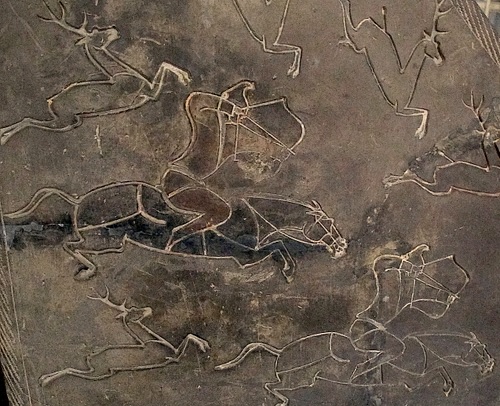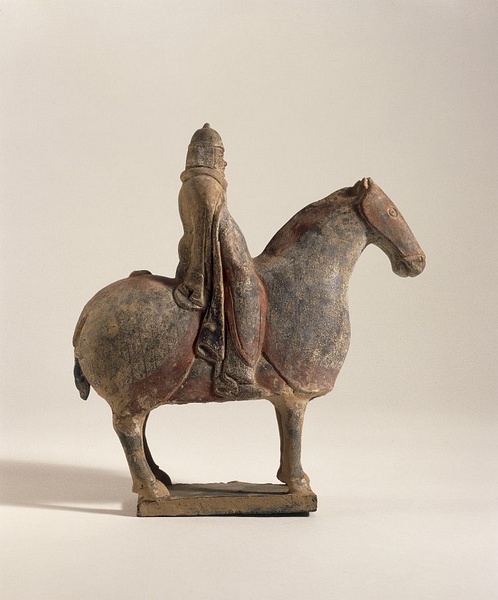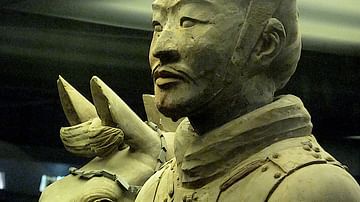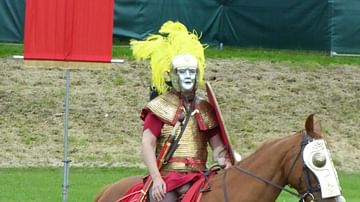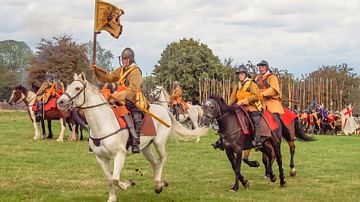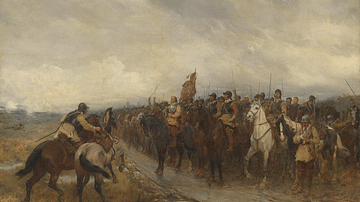The use of cavalry in Chinese warfare was a significant development which was largely responsible for the abandonment of chariots, that vehicle being much slower and more cumbersome to manoeuvre in battle conditions. The greater speed and mobility of cavalry not only changed battlefield dynamics and troop deployments but also necessitated a far greater investment in fixed defences than previously. An enemy which could attack at any time, on any terrain, and without warning became a disconcerting feature of Chinese warfare from the 4th century BCE onwards.
Origins & Developments
Although horses had been domesticated since Neolithic times in China, the animal was not ridden for centuries, perhaps only from the end of the Spring and Autumn period in the 5th century BCE did horse riding become common. A few historians continue to maintain that horses were ridden on hunting trips during the Shang dynasty (c. 1600 - 1046 BCE), but these views are in the minority and there is little supporting archaeological evidence.
The first encounters with horse riders by the Chinese would likely have been when they met nomadic peoples in the western border regions. The first were probably the Hu people in the late 4th century BCE who attacked the Chao and Yen states. An immediate effect of cavalry use was a realisation that static defences would have to be spread over a very wide area and maintained at high costs in order to combat a now much more mobile enemy. The Chinese were then quick to imitate the new approach to warfare, even copying the trousers and short jackets such foreign horse riders wore in an effort to wholly capture the magical effect of cavalry on what had been up to that point a somewhat static battlefield. There were practical developments in clothing too, with cumbersome robes and long coats replaced by jackets, boots, and trousers held up by buckles.
Still, despite its obvious advantages, cavalry units remained only a small corps within a much larger Chinese army until the Han period (206 BCE - 220 CE). The Qin state army of the 3rd century BCE was composed of only around 10% cavalry. Gradually, the prestige of the chariot and its obvious dramatic visual effect gave way to an understanding that the limiting necessity for level ground and their poor mobility when in action (four-horse chariots require a good deal of ground to make an about turn) meant that single horse riders were a far superior shock weapon. The armies of the early Han doubled the cavalry component to 20% of the total army and used it to good effect in Han founder, Liu Pang's battles with Hsiang Yu.
Selecting Horses & Men
Horses, indigenous to ancient China, were quite small compared to those available to the northern nomadic tribes of Asia, and now that cavalry troops had proven their worth, Chinese commanders began to look for better mounts. Emperor Wu (r. 141-87 BCE) embarked on several campaigns specifically to capture horses from the peoples of central Asia which were famous for being stronger, swifter and having greater endurance. The expedition was itself said to have included a 10,000-strong cavalry force.
Once acquired, horses were looked after well on state-controlled grasslands and stables where they were kept in cool sheds in summer and warm ones in winter. Their manes were kept trimmed, their hooves cared for, and in battle, they wore blinkers and ear protectors to minimise the effects on their nerves of the noise and action of the battlefield. To protect them to some degree from enemy spears, horses sometimes wore an armour-plated covering hanging from their necks made of bronze, iron and leather or cloth.
As to the men that would ride the horses, long training and great skill were required to manage a horse in battle conditions, especially given the primitive nature of saddles - usually only a rolled blanket - and the late arrival of stirrups (from the Han period). Even more skill was required to effectively use a weapon from this precarious seat - a lance, bow, halberd (a mix of axe and spear), or sword. For this reason, many dynasties simply recruited experienced riders from neighbouring states; a policy which continued into the Three Kingdoms period (220-280 CE). The 3rd century BCE military treatise the Six Secret Teachings by T'ai Kung has this to say on the skills required by cavalrymen:
The rule for selecting cavalry warriors is to take those under forty, who are at least seven feet five inches tall, strong and quick, who surpass the average. Men who, while racing a horse, can fully draw a bow and shoot. Men who can gallop forward and back, left and right, and all around, both advancing and withdrawing. Men who can jump over moats and ditches, ascend hills and mounds, gallop through narrow confines, cross large marshes, and race into a strong enemy, causing chaos among their masses. (Sawyer, 2007, 101)
Use & Tactics
Cavalry units were used as a shock weapon, just as their predecessor the chariot had been. Horsemen could attack the enemy to break up their infantry lines and disrupt the opposing commander's planned tactical formations. Armed with bows and able to fire them on the move, riders could engage in hit-and-run attacks. Being highly mobile, cavalry also allowed unorthodox tactics to be used on a battlefield which had once been somewhat formulaic in its troop deployments, especially during the ascendancy of chariots.
T'ai Kung describes his idea of the ideal deployment of cavalry:
Cavalry are the army's fleet observers, the means to pursue a defeated army, to sever supply lines, to strike roving forces…Ten cavalrymen can drive off one hundred infantrymen, and one hundred cavalrymen can run off one thousand men…As for the number of officers in the cavalry: a leader for five men; a captain for ten; a commander for one hundred; a general for two hundred.
The rule for fighting on easy terrain: Five cavalrymen will form one line, and front to back their lines should be separated by twenty paces, left to right four paces, with fifty paces between attachments.
On difficult terrain the rule is front to back, ten paces; left to right, two paces; between detachments, twenty-five paces. Thirty cavalrymen comprise a company; sixty form a regiment. For ten cavalrymen there is a captain. (Sawyer, 2007, 99-100)
While it is not certain if commanders in the field ever actually followed this advice, such military treatises were widely studied and even memorised by some commanders. It is also true that most were composed based on tried and tested methods. For how long such advice remained valid is another moot point.
One common deployment of cavalry was to set them at the wings of infantry formations, protecting them from outflanking manoeuvres by the enemy. Cavalry was also used to protect an armies rear when it was on the move. By the 2nd century BCE, cavalrymen carried shields but these were likely for fighting when they dismounted as most cavalry weapons required two hands to use. There are also episodes where commanders innovated such as one officer in Sima Yi's army who, in a battle in 303 CE, had a few thousand of his cavalrymen tie a double-ended halberd to either side of their horse before charging the enemy and gaining victory.
The adoption of the stirrup and better saddles meant that riders had much greater control of their mount and could carry heavier arms and armour. The 4th century CE saw the introduction of heavy cavalry with cataphract armour protecting the whole body of both the rider and the horse. The innovation was probably introduced into China from Manchuria, and their earliest depiction in art comes from a 357 CE Korean tomb (in an area then controlled by Chinese commanderies). Such heavy cavalry, used to bash a way through and disrupt enemy formations, softening them up before the infantry arrived, became the elite corps of the Chinese army and akin to the knights of medieval Europe.
Defences Against Cavalry
A defence tactic against cavalry units was to set wooden caltrops (spiked devices) in the ground the enemy was expected to approach. They are mentioned in the Six Secret Teachings:
Wooden caltrops which stick out of the ground about two feet five inches [70 cm]…They are employed to defeat infantry and cavalry, to urgently press the attack against invaders, and to intercept their flight…For narrow roads and small bypaths, set out iron caltrops eight inches [20 cm] wide, having hooks four inches high and shafts of more than six feet [1.8 m]…They are for defeating retreating cavalry. (Sawyer, 2007, 77-8)
Other defences against a band of marauding cavalry included the use of iron chains strung across paths, covered ditches, and setting spears into grassy ground at an angle with the point upwards, colourfully called “Dragon Grass”.
Later Cavalry & Decline
Cavalry continued to be used effectively into the Sui dynasty (581-618 CE) with, as before, riders often recruited from outside China. The Tang dynasty (618-907 CE), too, recruited from abroad and used East Turk and Uighur horsemen, mixing them with their own troops to form cavalry corps in their tens of thousands. That period also saw a return to a lighter and more mobile cavalry. However by the 9th century CE, and despite the continuance of elite cataphract units, cavalry had largely fallen out of favour as a major component of field armies, a decision the Chinese would later rue.
For history would eventually turn full circle and the Chinese armies, although they had once made themselves proficient users of cavalry, would again be taught a lesson in horsemanship and warfare by the steppe nomads just as they had been in the 5th century BCE. This time they were undone by the cavalry forces of the Mongol empire whose skill, speed, love of feigned retreats, and total lack of interest in positional warfare brought the “barbarians” victory after victory and eventual control of the Chinese state in the 13th century CE.

